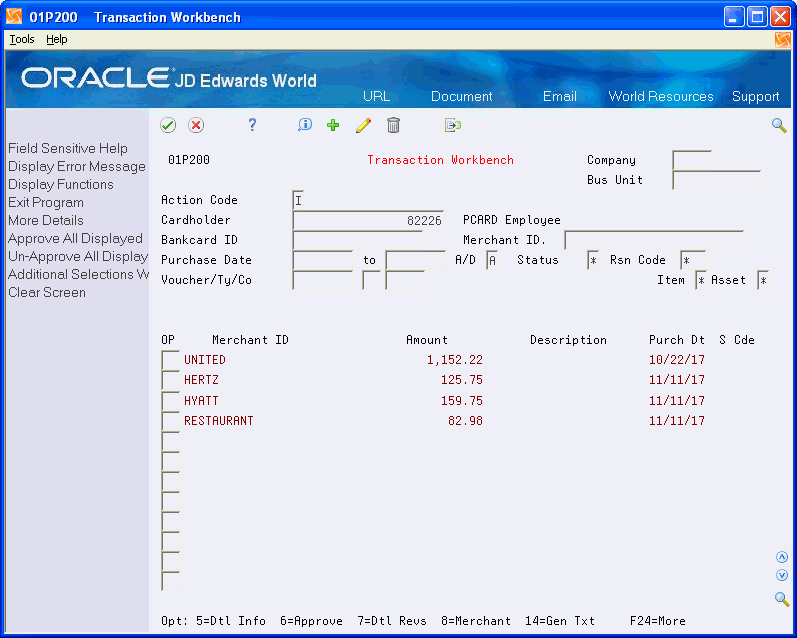5 Working with Unprocessed Purchase Cards Transactions
After you upload purchase card transactions from your bank, you use the Transaction Workbench (P01P200) to review and revise them. Management can approve or reject the transactions using the workbench. Depending on how often you receive transactions from the bank, you might review transactions daily, weekly, or monthly. After the transactions are approved you can create journal entries to record the expense. Once you generate a journal entry or voucher for a PCard transaction, the system considers it processed.
Three programs comprise the Transaction Workbench:
-
Transaction Workbench (P01P200)
Use this program to display PCard transactions by cardholder, bankcard ID, merchant ID, or purchase date, and to approve transactions that have been reviewed.
-
PCard Transaction/Information (P01P11)
Use this program to update the receipt status, as well as to enter purchase order document information.
-
Purchase Card Trans Details (P01P111)
Use this program to review and revise expense categories and the G/L account distribution. The system uses the account information when you create journal entries, and it uses the description from the Remark field, in the detail area, as the payment remark when you create vouchers.
You can use the following function exits:
-
Account/Expense Category Format Toggle (F2) to toggle the view between the account number or expense category.
-
Enhanced Subledgers (F12) to access the PCard Transactions Enhanced Subledgers program (P1601P1) to enter enhanced subledger information.
-
Alternatively, you can use the Approvals Management system to approve or reject transactions. When Approvals Management is active and a manager approves the transaction using P01P200, the status changes to 0 - Proceed through Approvals Management. You must then use the Approval Workbench program (P00A12) to complete the approval process. See Overview to Approvals Management in the JD Edwards World Technical Tools Guide for additional information about using this process.
Additionally, you can process purchase orders from the PCard system. See the following for more information:
-
Appendix F, "Redistributing PCard Logged Vouchers via Purchase Order Matching" for information on processing non-stock purchase orders from the PCard system.
-
Appendix G, "Adjusting Inventory for Stock Items" for information on updating inventory for stock items purchased using the purchase card.
This chapter contains these topics:
From Purchase Card Processing (G01P1), choose Transaction Processing
From Transaction Processing (G01P11), choose Transaction Workbench
| Topic | Description |
|---|---|
| Enhanced Subledger Accounting (ESA) | JD Edwards World provides a mechanism to summarize the Enhanced Subledger 1 and 2 fields when you run the Post program. This supersedes the standard set up. It allows you to specify summarization and also allows the optional entry of the subledger/type.
You set the Store Cardholder Number field in the Purchase Card Constants program (P01P00) in conjunction with UDC 01P/PO. ESA is a hard coded value in UDC 01P/PO. The Special Handling Code field of this UDC determines how the system summarizes journal entries. If you set this field to 1, Enhanced Subledgers 1 and 2 are summarized for PCard journal entries when you run the Post program. If you set the field to 2, Enhanced Subledgers 1 and 2 are summarized for all journal entries when you run the Post program. |
5.1 Reviewing and Revising Transactions
This section includes the following tasks:
-
To review purchase card transactions
-
To revise purchase card transactions
5.1.1 To Review Purchase Card Transactions
You use the Transaction Workbench program (P01P200) to locate and review PCard transactions. Use the Additional Selections Window (P01P200W) to locate and review asset or item information for a PCard transaction.
-
On Transaction Workbench, click Inquire to review all transactions.
-
To narrow your search, complete any of the following fields and click Inquire:
-
Company
-
Business Unit
-
Cardholder
-
Bankcard ID
-
Merchant ID
-
Purchase Dates
-
A/D (Ascending/Descending)
-
Reason Code
-
Item
-
Asset
-
-
To locate an item or asset, choose Additional Selections Window (F8).
-
On Additional Selections, perform one of the following and click Enter:
-
Complete the Item or Asset Number field.
-
Choose Field Sensitive Help in either field.
-
| Field | Explanation |
|---|---|
| Cardholder | Enter the address book number or name of the employee. |
| Bankcard ID | This value uniquely identifies a bankcard by combining the User ID of the card holder plus the last four characters/digits of the bankcard.
Screen-specific Information Enter the combination of the employee's address book number and last four digits of the purchase card to further limit the transactions that display. You must provide all eight characters of the address book number plus the last four digits of the credit card assigned to the employee to display transactions using this field. If the address book number is less than eight characters, use leading zeros. |
| Merchant ID | Enter the merchant ID provided to you by the bank. |
| Status | The status of the daily, weekly, or monthly bankcard transactions. The values allowed include:
|
| Reason Code | Used to provide an explanation for the Transaction Reason Status. If the Transaction Reason Status is '2', which indicates some issue needs to be resolved, this reason code is required.
Screen-specific Information Enter a value from UDC 01P/RC. |
| Voucher | A number that identifies the original document, such as a voucher, invoice, unapplied cash, journal entry, and so on. On entry forms, you can assign the original document number or let the system assign it through Next Numbers. |
| Type | A user defined code (00/DT) that identifies the origin and purpose of the transaction.
J.D. Edwards reserves several prefixes for document types, such as vouchers, invoices, receipts, and timesheets. Screen-specific Information Enter a value from UDC 00/DT. |
| Company | A number that, with the document number, document type and G/L date, uniquely identifies an original document, such as invoice, voucher, or journal entry.
If you use the Next Numbers by Company/Fiscal Year feature, the Automatic Next Numbers program (X0010) uses the document company to retrieve the correct Next Number for that company. If two or more original documents have the same document number and document type, you can use the document company to locate the desired document. |
| Item | This flag is used to indicate if an inventory item has been assigned to the transaction detail.
Valid Values: 1 = Inventory item has been assigned. blank = No inventory item has been assigned. |
| Asset | This flag is used to indicate if a fixed asset has been assigned to the transaction detail.
Valid Values: 1 = Fixed asset has been assigned. blank = No fixed asset has been assigned. |
5.1.2 To Revise Purchase Card Transactions
Before you approve a purchase card transaction, you might want to revise it to add a receipt status, purchase order information, or to add or change the account distribution. You can also add generic text. For example, if you require your cardholders scan their receipts, you can provide a link to the scanned receipt using generic text.
You use the PCard Transaction/Information program (P01P11) to revise a PCard transaction.
-
On Transaction Workbench, enter 5 in the Option field to access PCard Transaction/Information.
Figure 5-2 PCard Transaction /Information screen
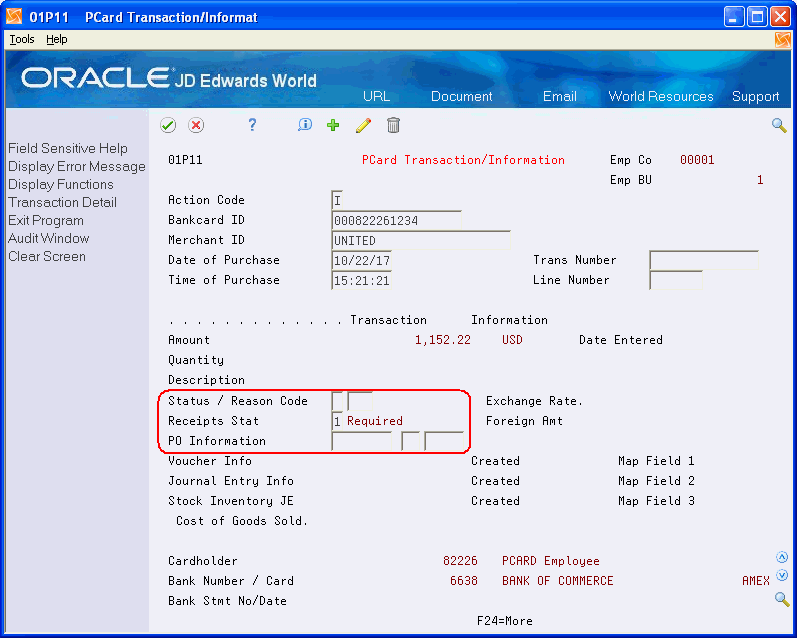
Description of "Figure 5-2 PCard Transaction /Information screen"
-
Complete any of the following fields and click Change:
-
Status
-
Reason Code
-
Receipts Status
-
PO (Purchase Order) Information
-
| Field | Explanation |
|---|---|
| Receipt Status | This flag will indicate the status of receipts for bank card purchases.
Allowed values include:
|
| PO Information/Document Type/Document Company | A document that authorizes the delivery of specified merchandise or the rendering of certain services. |
5.2 Working with G/L Account Distribution Information
You must specify the expense account to use to record the purchase before you can change the status to approved and generate journal entries or vouchers for it. If you use the CC Automatic Accounting Instructions (AAIs), the system automatically supplies the account number for you; otherwise, you can specify an account number or leave the account number blank on the F01PBKZ transaction before processing it, and then enter or update the account manually on the Purchase Card Trans Detail screen (P01P111)
Even if you use the CC AAIs, you might want to allocate the amount to different accounts. If you process receipt totals (summary mode), you might want to allocate the amount to accounts within multiple business units or to accounts for specific receipt items. For example, you might want to distribute the expense for an office party among several business units or you might want to allocate the amount for computer expenses to a different account than you use for office supplies, even though you purchase them from the same merchant.
|
Note: The amount that you distribute must equal the amount of the receipt item. The system displays both the Amount Calculated and Amount Remaining fields if the amount distributed does not equal the amount of the receipt. |
When you allocate expenses you can also assign merchant category codes (MCCs) for tracking purposes, as well as asset IDs or item numbers:
-
The system validates the MCC value that you enter against the Merchant Category Code file (F01P21).
-
The system validates the asset ID that you enter against the Asset Master file (F1201).
-
The system validates the item number that you enter against the Item Master file (F4101).
If you generate vouchers, you can enter a payment remark to assign to voucher pay items in the unlabeled field under the Description/Remark field in the detail area of the screen.
You can only revise the account information on purchase card transactions that have not been approved. After you create journal entries or vouchers for a transaction, you cannot revise any fields except the Reason Code (CDRC) and Receipts Status (CDSR) fields on P01P11.
The system stores G/L account distribution information in the Transaction Distribution File (F01P111).
This section includes the following tasks:
To revise G/L account distribution information
To add expense category information
To revise enhanced subledger information
To revise G/L account distribution
You use the Purchase Card Transaction Detail program (P01P111) to review, revise, and add asset or item information to a PCard transaction.
For item numbers, enter the number of the item that corresponds to the purchase order. To update inventory for stock items, you must first approve the transaction, and then you can choose Stock Inventory (F8).
|
Note: Once you stock the items, you cannot choose Stock Inventory (F8) to stock any items that you add at a later time. JD Edwards World recommends that you update all of the detail for all items on that transaction before you stock the items. Otherwise, you must manually stock any item that you add later. |
-
On Transaction Workbench, enter 7 in the Option field to access Purchase Card Transaction Details.
Figure 5-3 Purchase Card Transaction Details screen
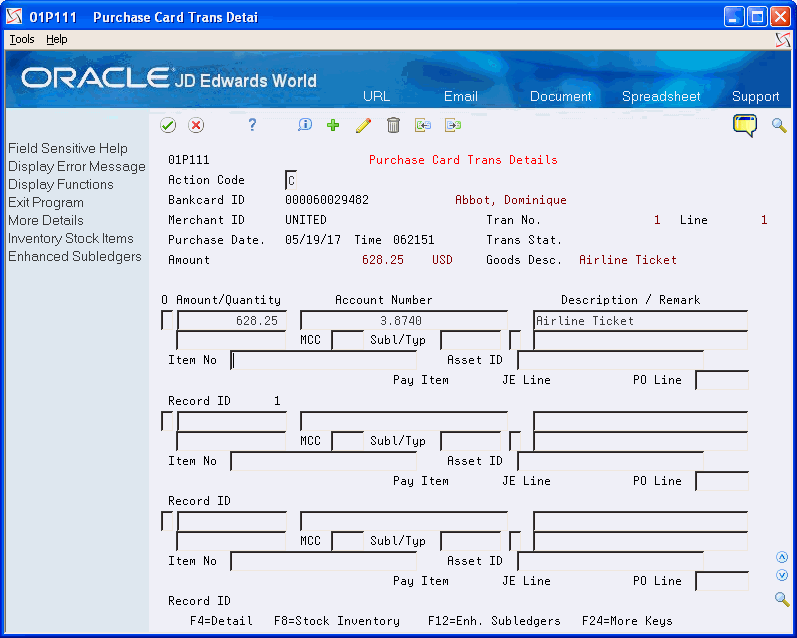
Description of "Figure 5-3 Purchase Card Transaction Details screen"
-
On Purchase Card Transaction Details access the detail area (F4) .
-
Complete any of the following fields and click Change.
-
Amount/Quantity
-
Expense Category
-
Description/Remark
-
MCC
-
Item Number
-
Asset ID
-
Reference 1 and 2
-
PO Line
-
Account Number
-
| Field | Explanation |
|---|---|
| PO Line | A number that identifies multiple occurrences, such as line numbers on a purchase order or other document. Generally, the system assigns this number, but in some cases you can override it. |
| Reference 1 and 2 | A number that provides an audit trail for specific transactions, such as a payment number for payment processing.
Screen-specific information The system updates the values that you enter to corresponding fields in the Account Ledger file (F0911) when you generate the journal entry for the purchase card transaction. |
To add expense category information
Using the Expense Category Selection Window (P01P04W), employees can choose the expense category that best describes the items they purchased and the system enters the accounting information. This allows you to more accurately account for each purchase. The expense categories group like items and share common accounting information, such as the same account or subledger.
Employees can also choose Account/Expense Category Format Toggle (F2) to toggle the view of the Expense Category and Account Number fields. Depending on which format they choose, one of these fields displays in the main area of the detail line and the other in the fold area of the detail line or vice versa. When employees choose an expense category from P01P04W, the account number displays on the Purchase Card Trans Details screen. Employees can enter a different account number if necessary or manually enter the account number or the expense category.
-
On Purchase Card Transaction Detail, toggle (F2) to display the Expense Category field, if necessary.
-
In the Expense Category field, choose Field Level Help (F1).
Figure 5-4 Expense Category Selection window
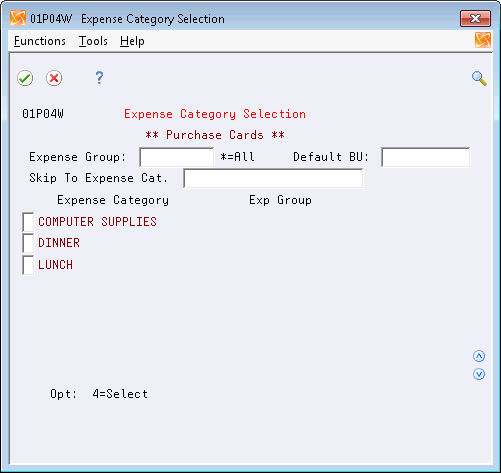
Description of "Figure 5-4 Expense Category Selection window"
-
On Purchase Card Transaction Detail, click Change.
To revise enhanced subledger information
Using the PCard Transaction - Enh. Subls. program (P1601P1), you can change enhanced subledgers for the transaction.
Depending on the value of the Store Cardholder field in the Purchase Card Constants (P01P00), the system might store the address book number of the employee in either the Enhanced Subledger Type 1 (ABR1) or Enhanced Subledger Type 2 (ABR2) fields. Otherwise, the system stores it in the Subledger field (SBL) that displays on the Purchase Card Trans Details screen (P01P111).
-
On Purchase Card Transaction Detail, choose Enhanced Subledger (F12) to access PCard Transaction - Enh. Subls.
Figure 5-5 PCard Transaction - Enhanced Subledger screen
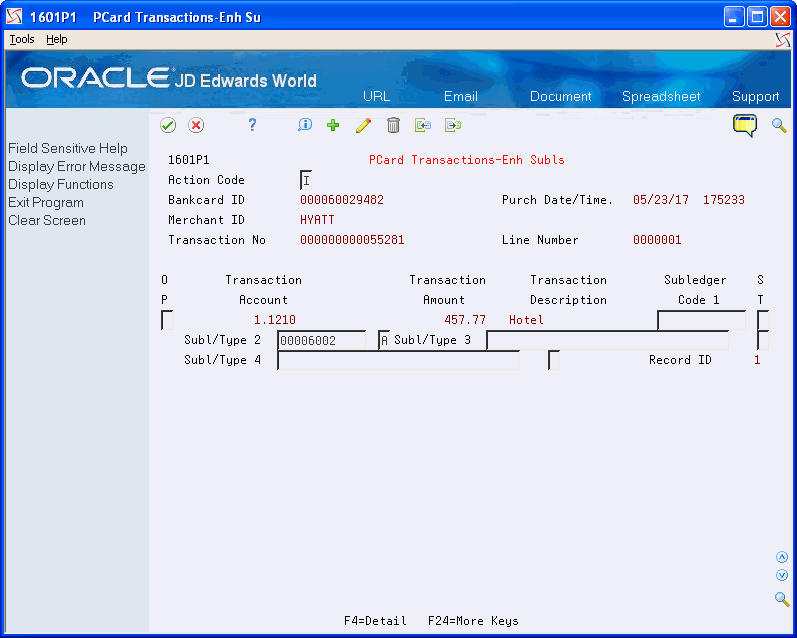
Description of "Figure 5-5 PCard Transaction - Enhanced Subledger screen"
-
On PCard Transaction - Enh. Subls. access the detail area.
-
Complete the following fields and click Change:
-
Enhanced Subledger 1-4
-
Subledger Type 1-4
-
-
On Purchase Card Transaction Detail, click Change.
5.3 Approving Transactions
Before you can generate journal entries or vouchers for purchase card transactions, they must be approved. You can approve one or more transactions using the Transaction Workbench. If you approve a transaction in error, you can also unapprove it, as long as you have not generated journal entries or vouchers for it. The system updates the Status field (CDSP) to 1 when you approve transactions. Once you generate journal entries or vouchers, you cannot change the approval status or make any revisions except to the Reason Code (CDSR) and Receipts Status (CDSR) on P01P11.
If Approvals Management is active and a manager approves the transaction using P01P200, the status changes to 0 - Proceed through Approvals Management. You must then use the Approval Workbench program (P00A12) to complete the approval process. See Overview to Approvals Management in the JD Edwards World Technical Tools Guide for additional information about using this process.
On Transaction Workbench, perform one of the following:
-
To approve all transactions, choose Approve All Displayed (F5). The system loads 6 in the Option field for all detail lines. Press Enter to complete the task.
-
To approve a single transaction, use Option 6 (Approve) and press Enter.
-
To unapprove all transactions, choose Un-approve All Displayed (F6). The system loads 11 in the Option field for all detail lines. Press Enter to complete the task.
-
To unapprove a single transaction, use Option 11 (Unapprove) and press Enter.
5.4 Rejecting Transactions
You cannot reject transactions directly from the Transaction Workbench; you must enter 2 in the Status field in the PCard Transaction/Information program (P01P11) to prevent transactions from being processed. You must then revise the transactions before they are approved and you create journal entries or vouchers for the transactions. See Section 5.1, "Reviewing and Revising Transactions."
If Approvals Management is active and a manager rejects the transaction, the status changes to 2 - Do Not Process Transaction. You must then revise the transaction to complete the approval process. See Overview to Approvals Management in the JD Edwards World Technical Tools Guide for additional information about using this process.
